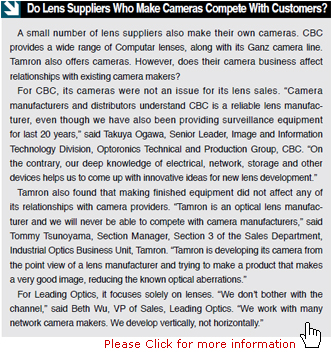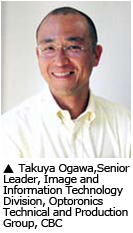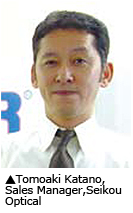Lenses are essentially ground the same way, but their installation affects image quality significantly. This second of two articles explores practical installation tips along with development hurdles.
Lenses are essentially ground the same way, but their installation affects image quality significantly. This second of two articles explores practical installation tips along with development hurdles.
Capturing good images is an interplay of quality equipment, installation and environmental factors. Getting a lens to perform well requires accounting for lighting, field of view and camera angle.
Illumination can be an issue even for controlled indoor environments. “The primary example of this is in casinos where installation crews invariably want to mount a camera directly above the gaming table right next to a bright spot light and expect a great shot,” said T. Riley Pierce, Senior Consultant and Project Manager, R. Grossman & Associates. “The light spectrum from the ceiling lights will cause ‘hot spots' on the table view if the camera look angle or the lighting assembly isn't adjusted to alleviate this problem.”
Image detail may vary, depending on where things are in relation to the camera.
A varifocal lens set to its widest setting of 2.6mm will provide a good overall view of the scene, but the end user will not get the same clarity over the entire shot. “An inherent factor with varifocal lenses is that they can provide a wide spectrum for adjustment,” Pierce said. “However the lens will not provide a completely sharp image across the entire view.”
One of Pierce's worst experiences with mismatched cameras and lenses was in a casino. The scene had a split-screen view of the table layout and the wheel head.
“The integrator kept insisting that the lenses he had specified would be sufficient for the shots; however, the Gaming Commission and I didn't agree with him,” Pierce said. “After he tried other lenses and camera bodies, he relented and went with a longer varifocal combo that produced the shot that kept the Gaming Commission and me happy.”
Field of view is a primary consideration. “You need to decide what it is you want to capture in the image and determine how many feet wide and high you need to capture the level of image you want,” Brissette said. “The main thing you are after is trying to cover assets and placing cameras where there are choke points where people will have to pass through.”
Temperature
Environmental factors such as climate can affect image quality. “Some places have a wide range in temperatures,” said Alf Chang, Senior Consultant for A&S magazines. “Installers need to make sure the lens doesn't frost over or accumulate moisture. If there are big temperature changes, the installer will have to make sure the lens operation range is sufficient.”
 In extremes of heat, most lenses can manage temperatures from 60 to 70 degrees Celsius. “I've seen some industrial applications when temperature was not factored in and the lenses just melted in 100- and 200-degree temperatures,” Chang said.
In extremes of heat, most lenses can manage temperatures from 60 to 70 degrees Celsius. “I've seen some industrial applications when temperature was not factored in and the lenses just melted in 100- and 200-degree temperatures,” Chang said.
Applications such as roasting coffee beans require a watchful eye and heat protection. Factory operations with open flames require lenses with fire filters, so users can see the flame's core instead of a red haze.
In cooler environments, lenses need to be bundled up. “For outdoor or speed dome lenses, they have their own heaters and housings, offering some protection,” Chang said. “You wouldn't place a lens naked outdoors.”
Wear
Practical issues such as wear and tear affect lens performance.“Whenever possible,avoid mechanical moving parts like auto-iris and motorized zoom lenses,” said Paul Bodell, VP of Global Business Development for IQinVision. “These lenses tend to break, and you will notice that many manufacturers exclude such lenses from warranties.”
However, the benefits of motorized lenses may outweigh their risks. “I have used cameras that had lenses that were not auto-iris,” said Peter Brissette, owner of www.cctv-security- camera-systems.com . “It was very difficult to get good consistent images. I would never recommend using any lens that does not have an auto iris.”
 Lens Development
Lens Development
Several vendors are working to improve lens bottlenecks. Currently, few lenses on the market can meet both megapixel and IR requirements. “A better optical design can do both and have better day/night performance,” said Beth Wu, VP of Sales, Leading Optics. “We can deliver lenses that perform well in ambient and IR light, at a level acceptable to customers.”
Tamron has worked on stepping motors for megapixel lenses as well as vibration compensation. “Tamron is now developing a telephoto AF zoom lens for board cameras with a built-in optical vibration compensator,'” said Tommy Tsunoyama, Section Manager, Section 3 of the Sales Department, Industrial Optics Business Unit,, Tamron. It will correct images optically, providing clear images without digital manipulation.
CBC is developing lenses that mix optical designs and electrical technologies, like its motorized zoom and focus (MFZ). “For board mount varifocal lenses, we would like to expand the MFZ that is CBC's original technology designed for the remote and precise control of zoom and focus with a stepping motor,” said Takuya Ogawa, Senior Leader, Image and Information Technology Division, Optoronics Technical and Production Group, CBC. “The technology enables installation to be very simple and low-cost.”
The company's P-iris technology for network cameras controls image quality better, such as contrast, brightness and depth of field, Ogawa said.
 Mega Challenges
Mega Challenges
As the number of megapixel cameras increases, lenses must keep up with demand. However, as more pixels are crammed on image sensors, lenses need to work overtime to focus light correctly. A pixel must be positioned in an area where its light does not interfere with the next pixel, or the depth of focus.
Depth of focus is 0.04 mm for 270,000 pixels, or roughly CIF resolution. This shrinks to 0.02 mm for 1.3-megapixel resolution, which makes megapixel sensors considerably more difficult to focus compared to SD ones.
In light of technical difficulties, a megapixel lens does not have to multiply the number of megapixels. “I don't think a lens manufacturer really needs to go farther than what is currently available, since the majority of the current manufacturers haven't ramped up their camera bodies to match what is available with lenses today,” Pierce said.
However, some camera makers feel differently. While megapixel cameras have been around for some time, surveillance-grade megapixel cameras have only emerged from 2009, said David Wang, Project Manager for Hikvision Digital Technology. “Image sensor development has far outstripped optical providers in terms of pixels. The market has a number of 5-megapixel cameras, but there is little choice for 5-megapixel lenses.”
A megapixel camera does require a dedicated megapixel lens. “SD lenses are not built to handle the types of views you can get with a megapixel camera,” Brissette said. “Most megapixel camera manufactures, however, can make recommendations on which lenses work best with their cameras.”
 Currently, corners are a challenge for megapixel lenses, as their aspherical shapes do not perform consistently. “If you take a color chart, you should be able to see lines in the corners clearly,” Chang said. “The curvature cannot be too great.”
Currently, corners are a challenge for megapixel lenses, as their aspherical shapes do not perform consistently. “If you take a color chart, you should be able to see lines in the corners clearly,” Chang said. “The curvature cannot be too great.”
As video surveillance becomes more high-end, the pixel size for megapixel cameras gets smaller. “Megapixel cameras are harder to focus,” Wu said. “The design difficulty is tougher, with higher requirements for materials and lens curvature. The tolerance is trickier.”
Adjusting megapixel lenses is difficult with the tight depth of focus. “Our main challenges for megapixel lenses are not only for new optical designs in higher resolution and IR compatibility, but also for motorized mechanisms or control algorithms of zoom, focus and iris that provide image control capabilities and remote-adjustment capabilities,” Ogawa said.
CMOS sensors accommodate extra pixels for megapixel cameras, resulting in a boom of CMOS players entering surveillance. “On the other hand, sensor size, sensor height, axis position, resolution, color rendition rate and so on are not standardized,” Tsunoyama said. “The challenges are to come up with a method to match these differences.”
While megapixel is hot, its high cost could inhibit uptake. “As we believe that the key factor for increase sales of megapixel lenses is price, we are seeking what is the best technical and mechanical development to keep high performance and lower manufacturing cost,” said Tomoaki Katano, Sales Manager, Seikou Optical.
Unscrupulous Providers
 While lens makers are generally reputable, some cut corners when they deliver final products. “Some lens vendors use great demonstration samples but deliver subpar products,” Chang said. “A city surveillance project looked great in demos, but wasn't as good in real life.”
While lens makers are generally reputable, some cut corners when they deliver final products. “Some lens vendors use great demonstration samples but deliver subpar products,” Chang said. “A city surveillance project looked great in demos, but wasn't as good in real life.”
For example, the lens serial number will be the same in the front, but may end in dash-1, dash-2 or dash-3. “Unscrupulous vendors will lie that a dash-3 lens is the same as the dash-1 lenses,” Chang said. “The density will differ by a grade, so it will be cheaper and deliver worse quality. The lens blank makes a huge difference.”
Buyers should not believe specifications on paper. “We have seen lenses that were rated as ‘megapixel' produce terrible images,” Bodell said. “We have also seen very inconsistent lens performance from the lower-cost manufacturers. Just because a trade show sample looks good doesn't mean all the manufacturer's lenses will perform the same way.”
At the end of the day, lens development boils down to seeing clearly. While some makers have lost sight of that goal in favor of short-term profits, a number of optical providers strive to deliver the whole picture.
Determining whether a lens is good depends on its engineering, user friendliness and adaptation to its environment. A quality lens delivers clear results.